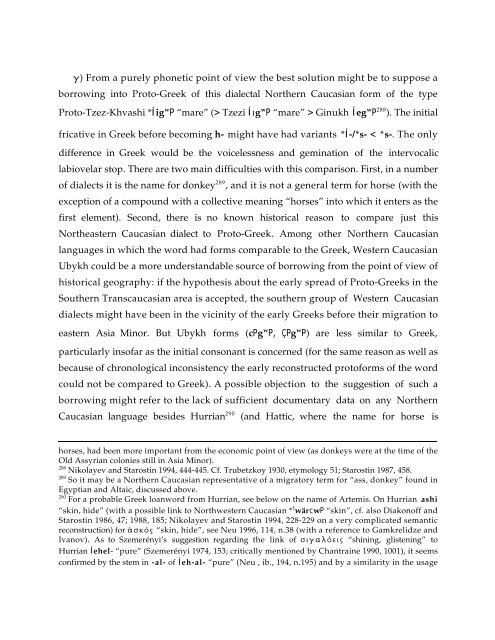Comparative Notes on Hurro-Urartian, Northern Caucasian
Comparative Notes on Hurro-Urartian, Northern Caucasian
Comparative Notes on Hurro-Urartian, Northern Caucasian
You also want an ePaper? Increase the reach of your titles
YUMPU automatically turns print PDFs into web optimized ePapers that Google loves.
g) From a purely ph<strong>on</strong>etic point of view the best soluti<strong>on</strong> might be to suppose a<br />
borrowing into Proto-Greek of this dialectal <strong>Northern</strong> <strong>Caucasian</strong> form of the type<br />
Proto-Tzez-Khvashi *Íig w P “mare” (> Tzezi ÍIg w P “mare” > Ginukh Íeg w P 288 ). The initial<br />
fricative in Greek before becoming h- might have had variants *Í-/*s- < *s-. The <strong>on</strong>ly<br />
difference in Greek would be the voicelessness and geminati<strong>on</strong> of the intervocalic<br />
labiovelar stop. There are two main difficulties with this comparis<strong>on</strong>. First, in a number<br />
of dialects it is the name for d<strong>on</strong>key 289 , and it is not a general term for horse (with the<br />
excepti<strong>on</strong> of a compound with a collective meaning “horses” into which it enters as the<br />
first element). Sec<strong>on</strong>d, there is no known historical reas<strong>on</strong> to compare just this<br />
Northeastern <strong>Caucasian</strong> dialect to Proto-Greek. Am<strong>on</strong>g other <strong>Northern</strong> <strong>Caucasian</strong><br />
languages in which the word had forms comparable to the Greek, Western <strong>Caucasian</strong><br />
Ubykh could be a more understandable source of borrowing from the point of view of<br />
historical geography: if the hypothesis about the early spread of Proto-Greeks in the<br />
Southern Transcaucasian area is accepted, the southern group of Western <strong>Caucasian</strong><br />
dialects might have been in the vicinity of the early Greeks before their migrati<strong>on</strong> to<br />
eastern Asia Minor. But Ubykh forms (cPg w P, ÇPg w P) are less similar to Greek,<br />
particularly insofar as the initial c<strong>on</strong>s<strong>on</strong>ant is c<strong>on</strong>cerned (for the same reas<strong>on</strong> as well as<br />
because of chr<strong>on</strong>ological inc<strong>on</strong>sistency the early rec<strong>on</strong>structed protoforms of the word<br />
could not be compared to Greek). A possible objecti<strong>on</strong> to the suggesti<strong>on</strong> of such a<br />
borrowing might refer to the lack of sufficient documentary data <strong>on</strong> any <strong>Northern</strong><br />
<strong>Caucasian</strong> language besides Hurrian 290 (and Hattic, where the name for horse is<br />
horses, had been more important from the ec<strong>on</strong>omic point of view (as d<strong>on</strong>keys were at the time of the<br />
Old Assyrian col<strong>on</strong>ies still in Asia Minor).<br />
288 Nikolayev and Starostin 1994, 444-445. Cf. Trubetzkoy 1930, etymology 51; Starostin 1987, 458.<br />
289 So it may be a <strong>Northern</strong> <strong>Caucasian</strong> representative of a migratory term for “ass, d<strong>on</strong>key” found in<br />
Egyptian and Altaic, discussed above.<br />
290 For a probable Greek loanword from Hurrian, see below <strong>on</strong> the name of Artemis. On Hurrian ashi<br />
“skin, hide” (with a possible link to Northwestern <strong>Caucasian</strong> * ? wärćwP “skin”, cf. also Diak<strong>on</strong>off and<br />
Starostin 1986, 47; 1988, 185; Nikolayev and Starostin 1994, 228-229 <strong>on</strong> a very complicated semantic<br />
rec<strong>on</strong>structi<strong>on</strong>) for éskÒw “skin, hide”, see Neu 1996, 114, n.38 (with a reference to Gamkrelidze and<br />
Ivanov). As to Szemerényi’s suggesti<strong>on</strong> regarding the link of sigalÒeiw “shining, glistening” to<br />
Hurrian Íehel- “pure” (Szemerényi 1974, 153; critically menti<strong>on</strong>ed by Chantraine 1990, 1001), it seems<br />
c<strong>on</strong>firmed by the stem in -al- of Íeh-al- “pure” (Neu , ib., 194, n.195) and by a similarity in the usage





